The Increase in the Elastic Range and Strengthening Control of Quasi Brittle Cement Composites by Low-Module Dispersed Reinforcement: An Assessment of Reinforcement Effects
Abstract
1. Introduction
2. Materials and Methods
2.1. Materials Used for Tests
2.2. Preparation of Specimens for Tests
2.3. Description of the Test Stand
- -
- Tensile strength at bending fmax (MOR, the modulus of rupture), tensile strength at first crack fcr (LOP, the limit of proportionality);
- -
- The characteristic points on the load-deflection curve, fx(Fx-load, εx-deflection, and Wx-energy);
- -
- Energy (work) as proportional to the area under the load-deflection curve up to the characteristic point.
3. Test Results
4. Discussion
5. Conclusions
Author Contributions
Funding
Data Availability Statement
Conflicts of Interest
References
- Banthia, N.; Sappakittipakorn, M. Toughness enhancement in steel fibre reinforced concrete through fibre hybridization. Cem. Concr. Res. 2007, 37, 1366–1372. [Google Scholar] [CrossRef]
- Banthia, N.; Soleimani, S.M. Flexural response of hybrid fibre reinforced cementitious composites. ACI Mater. J. 2005, 192, 5. [Google Scholar]
- Bentur, A.; Mindess, S. Fibre Reinforced Cementitious Composites; Elsevier: London, UK, 1990. [Google Scholar]
- Brandt, A.M. Fibre reinforced cement-based (FRC) composites after over 40 years of development in building and civil engineering. Compos. Struct. 2008, 86, 3–9. [Google Scholar] [CrossRef]
- Brandt, A.M. Cement Based Composites. Materials Mechanical Properties and Performance, 2nd ed.; Taylor & Francis: Abingdon, UK, 2009. [Google Scholar]
- Campione, G.; Mindess, S.; Papia, M. Tensile strength of medium and high strength fibre reinforced concrete: A Comparison of different testing techniques. In Proceedings of the Brittle Matrix Composites 6, Warsaw, Poland, 9–11 October 2000; pp. 83–92. [Google Scholar]
- Chen, M.; Zhong, H.; Zhang, M. Behaviour of recycled tyre polymer fibre reinforced concrete under dynamic splitting tension. Cem. Concr. Compos. 2020, 114, 103764. [Google Scholar] [CrossRef]
- Deng, Z. The fracture and fatigue performance in flexure of carbon fibre reinforced concrete. Cem. Concr. Compos. 2005, 27, 131–140. [Google Scholar] [CrossRef]
- Fantilli, A.P.; Jóźwiak-Niedźwiedzka, D. The effect of hydraulic cements on the flexural behavior of wool reinforced mortars. Acad. J. Civ. Eng. 2020, 37, 287–292, ISSN 2680-1000. [Google Scholar] [CrossRef]
- Felekoğlu, B.; Tosun, K.; Baradan, B. Effects of fibre type and matrix structure on the mechanical performance of self-compacting micro-concrete composites. Cem. Concr. Res. 2009, 39, 1023–1032. [Google Scholar] [CrossRef]
- Cascardi, A.; Lerna, M.; Micelli, F.; Aiello, M.A. Discontinuous FRP-Confinement of Masonry Columns. Front. Built Environ. 2020, 5, nr 147. [Google Scholar] [CrossRef]
- Foti, D. Innovative techniques for concrete reinforcement with polymers. Constr. Build. Mater. 2016, 112, 202–209. [Google Scholar] [CrossRef]
- Foti, D. Preliminary analysis of concrete with waste bottles PET fibers. Constr. Build. Mater. 2011, 25, 1906–1915. [Google Scholar] [CrossRef]
- Glinicki, M.A. Testing of macro-fibre reinforced concrete for industrial floors. Cem. Lime Concr. 2008, 4, 184–195, ISSN 1425-8129. [Google Scholar]
- Hsie, M.; Tu, C.; Song, P.S. Mechanical properties of polypropylene hybrid fibre-reinforced concrete. Mater. Sci. Eng. 2008, 494, 153–157. [Google Scholar] [CrossRef]
- Jasieńko, J.; Logoń, D.; Misztal, W. Trass-lime reinforced mortars in strengthening and reconstruction of historical masonry walls. Constr. Build. Mater. 2016, 102, 884–892. [Google Scholar] [CrossRef]
- Kanda, T.; Li, V.C. Interface property and apparent strength of high-strengthhydrophilicfibre in cement matrix. J. Mater. Civ. Eng. 1998, 10, 5–13. [Google Scholar] [CrossRef]
- Kang, S.-T.; Kim, J.-K. The relation between fibre orientation and tensile behavior in an Ultra High Performance Fibre Reinforced Cementitious Composites (UHPFRCC). Cem. Concr. Res. 2011, 41, 1001–1014. [Google Scholar] [CrossRef]
- Karihaloo, L. Optimum design of high-performance steel fibre-reinforced concrete mix. In Proceedings of the Brittle Matrix Composites 6, Warsaw, Poland, 9–11 October 2000; pp. 3–16. [Google Scholar]
- Kim, D.J.; Naaman, A.E.; El-Tawil, S. Comparative flexural behavior of four fibre reinforced cementitious composites. Cem. Concr. Compos. 2008, 30, 917–928.1032B. [Google Scholar] [CrossRef]
- Kucharska, L.; Logoń, D. Influence of the composition of matrices in HPFRCC on the effects of their ageing. In Proceedings of the Non-Traditional Cement & Concrete II, Brno, Czech Republic, 14–16 June 2005; pp. 344–353. [Google Scholar]
- Kucharska, L.; Brandt, A.M. Pitch-based carbon fibre reinforced cement composites. In Materials Engineering Conference ASCE. Materials for the New Millenium; Chong, K.P., Ed.; ASCE: Washington, DC, USA, 1996; Volume 1, pp. 1271–1280. [Google Scholar]
- Logoń, D. FSD cement composites as a substitute for continuous reinforcement. In Proceedings of the Eleventh International Symposium on Brittle Matrix Composites BMC-11, Warsaw, Poland, 28–30 September 2015; Brandt, A.M., Ed.; Institute of Fundamental Technological Research: Warsaw, Poland, 2015; pp. 251–260. [Google Scholar]
- Logoń, D. Hybrid reinforcement in SRCC concrete. In Proceedings of the Third International Conference on Sustainable Construction Materials and Technologies SCMT3, Kyoto, Japan, 18–21 August 2013; p. e154. [Google Scholar]
- Logoń, D. Quality control of cement mixes using cube flow and electrical resistance tests. In Proceedings of the Non-Traditional Cement & Concrete IV, Brno, Czech Republic, 27–30 June 2011; Bílek, V., Keršner, Z., Eds.; Brno University of Technology: Brno, Czech Republic, 2011; pp. 238–247. [Google Scholar]
- Logoń, D.; Schabowicz, K.; Wróblewski, K. Assessment of the mechanical properties of ESD pseudoplastic resins for joints in working elements of concrete structures. Materials 2020, 13, 2426. [Google Scholar] [CrossRef]
- Logoń, D. The application of acoustic emission to diagnose the destruction process in FSD cement composites. In Proceedings of the International Symposium on Brittle Matrix Composites BMC-11, Warsaw, Poland, 28–30 September 2015; Brandt, A.M., Ed.; Institute of Fundamental Technological Research: Warsaw, Poland, 2015; pp. 299–308. [Google Scholar]
- Logoń, D. Safe cement composites SRCC—The rope effect in HPFRC concrete. In Brittle Matrix Composites; BMC 10; Elsevier: Warsaw, Poland, 2012; pp. 253–254. [Google Scholar]
- Naaman, E.; Reinhardt, H.W. Proposed classification of HPFRC composites based on their tensile response. Mat. Struct. 2006, 39, 547–555. [Google Scholar] [CrossRef]
- Naaman, A.E. Engineered steel fibres with optimal properties for reinforcement of cement composites. J. Adv. Concr. Technol. 2003, 1, 241–252. [Google Scholar] [CrossRef]
- Naaman, A.E.; Reinhardt, H.W. High Performance Fibre Reinforced Cement Composites (HPFRCC4); Pro 30; RILEM: Paris, France, 2003; p. 546. [Google Scholar]
- Nataraja, M.C.; Dhang, N.; Gupta, A.P. Toughness characterization of steel fibre-reinforced concrete by JSCE approach. Cem. Concr. Res. 2000, 30, 593–597. [Google Scholar] [CrossRef]
- Qian, C.X.; Stroeven, P. Development of hybrid polypropylene-steel fibre-reinforced concrete. Cem. Concr. Res. 2000, 30, 63–69. [Google Scholar] [CrossRef]
- Ranachowski, Z.; Schabowicz, K. The contribution of fibre reinforcement system to the overall toughness of cellulose fibre concrete panels. Constr. Build. Mater. 2017, 156, 1028–1034. [Google Scholar] [CrossRef]
- Šimonová, H.; Topolář, L.; Schmid, P.; Keršner, Z.; Rovnaník, P. Effect of carbon nanotubes in metakaolin-based geopolymer mortars on fracture toughness parameters and acoustic emission signals. In Proceedings of the BMC 11 International Symposium on Brittle Matrix Composites, Warsaw, Poland, 28–30 September 2015; pp. 261–288. [Google Scholar]
- Sun, Z.; Xu, Q. Microscopic, physical and mechanical analysis of polypropylene fibre reinforced concrete. Mater. Sci. Eng. A 2009, 527, 198–204. [Google Scholar] [CrossRef]
- Taylor, M.; Lydon, F.D.; Barr, B.I.G. Toughness measurements on steel fibre-reinforced high strength concrete. Cem. Concr. Compos. 1997, 19, 329–340. [Google Scholar] [CrossRef]
- Xu, B.; Toutanji, A.H.; Gilbert, J. Impact resistance of poly(vinyl alcohol) fibre reinforced high-performance organic aggregate cementitious material. Cem. Concr. Res. 2010, 40, 347–351. [Google Scholar] [CrossRef]
- Yao, W.; Li, J.; Wu, K. Mechanical properties of hybrid fibre-reinforced concrete at low fibre volume fraction. Cem. Concr. Res. 2003, 33, 27–30. [Google Scholar] [CrossRef]
- ASTM 1018. Standard Test Method for Flexural Toughness and First Crack Strength of Fibre–Reinforced Concrete; American Society for Testing and Materials: Philadelphia, PA, USA, 1992; Volume 04.02. [Google Scholar]
- EN 14651. Test Method for Metallic Fibre Concrete. Measuring the Flexural Tensile Strength (Limit of Proportionality (LOP), Residual); European Committee for Standarization: Brussels, Belgium, 2005. [Google Scholar]
- Japan Concrete Institute Standard JCI-S-003-2007. Method of Test for Bending Moment–Curvature Curve of Fibre-Reinforced Cementitious Composites; Japan Concrete Institute: Tokyo, Japan, 2007. [Google Scholar]
- Japan Concrete Institute Standard JCI-S-002-2003. Method of Test for Load-Displacement Curve of Fibre Reinforced Concrete by Use of Notched Beam; Japan Concrete Institute: Tokyo, Japan, 2003. [Google Scholar]
- Japan Concrete Institute Standard JCI-S-001-2003. Method of Test for Fracture Energy of Concrete by Use of Notched Beam; Japan Concrete Institute: Tokyo, Japan, 2003. [Google Scholar]
- TC Membership. RILEM TC 162-TGF: Test and Design Methods for Steel Fibre Reinforced Concrete; Bending Test. Final Recommendation; International Union of Laboratories and Experts in Construction Materials, Systems and Structures: Paris, France, 2002; Volume 35, pp. 579–582. [Google Scholar]
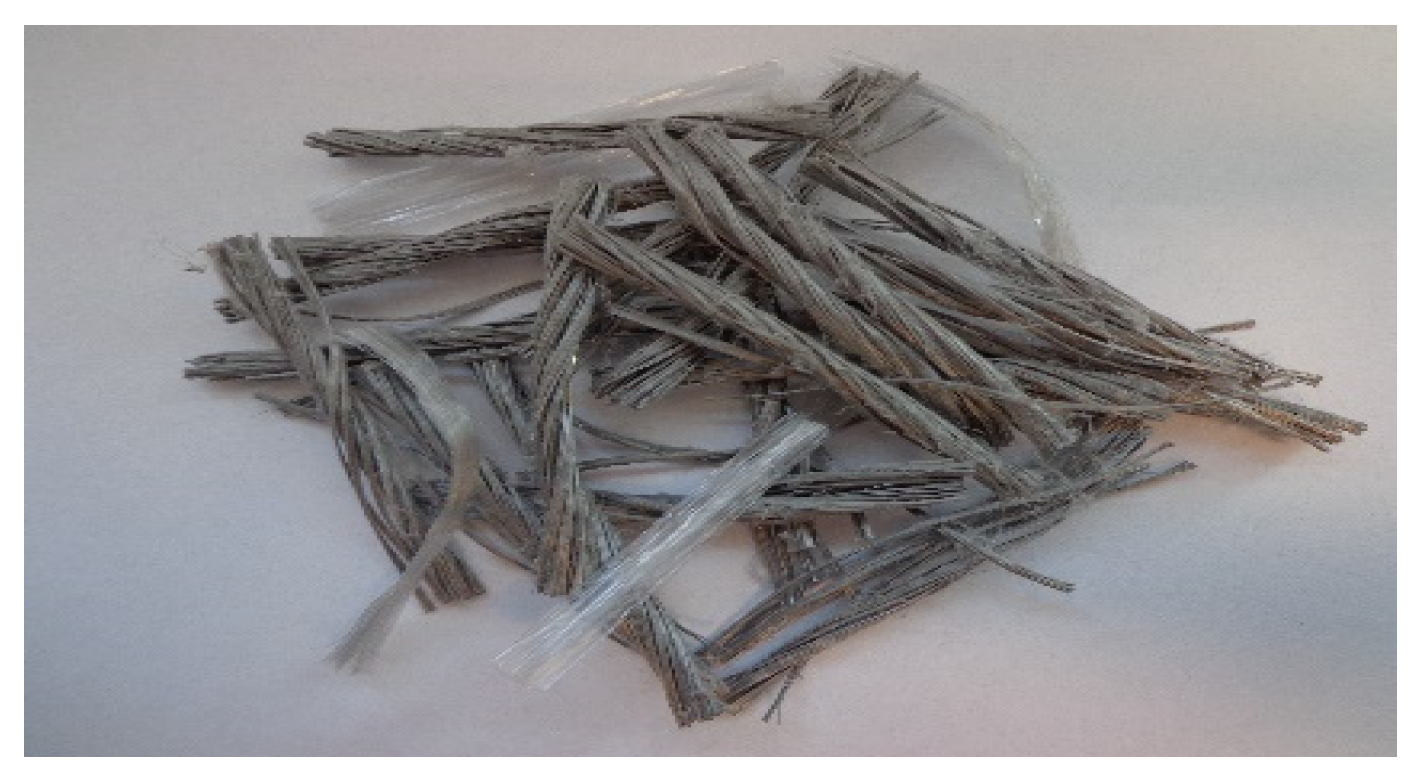
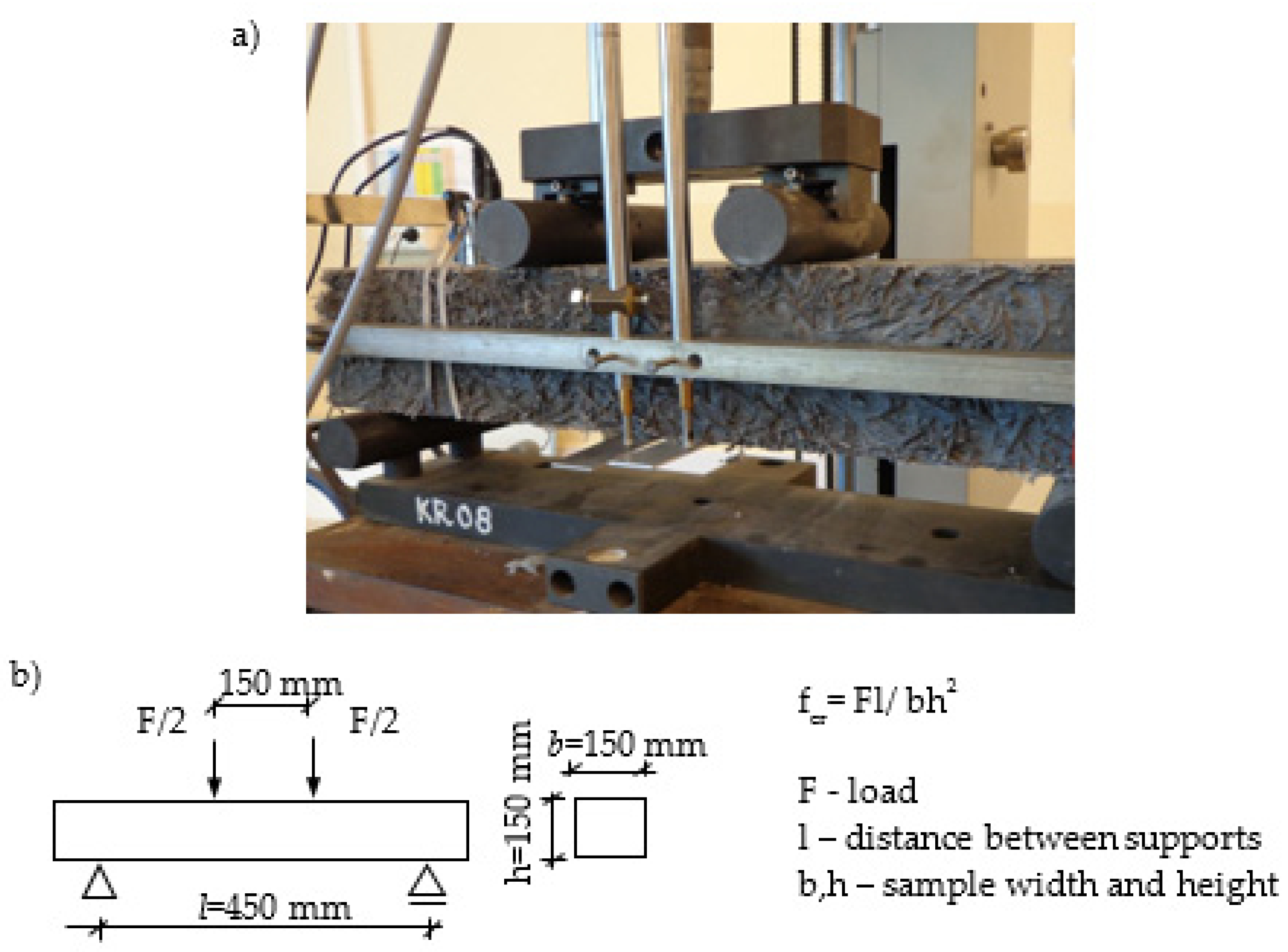
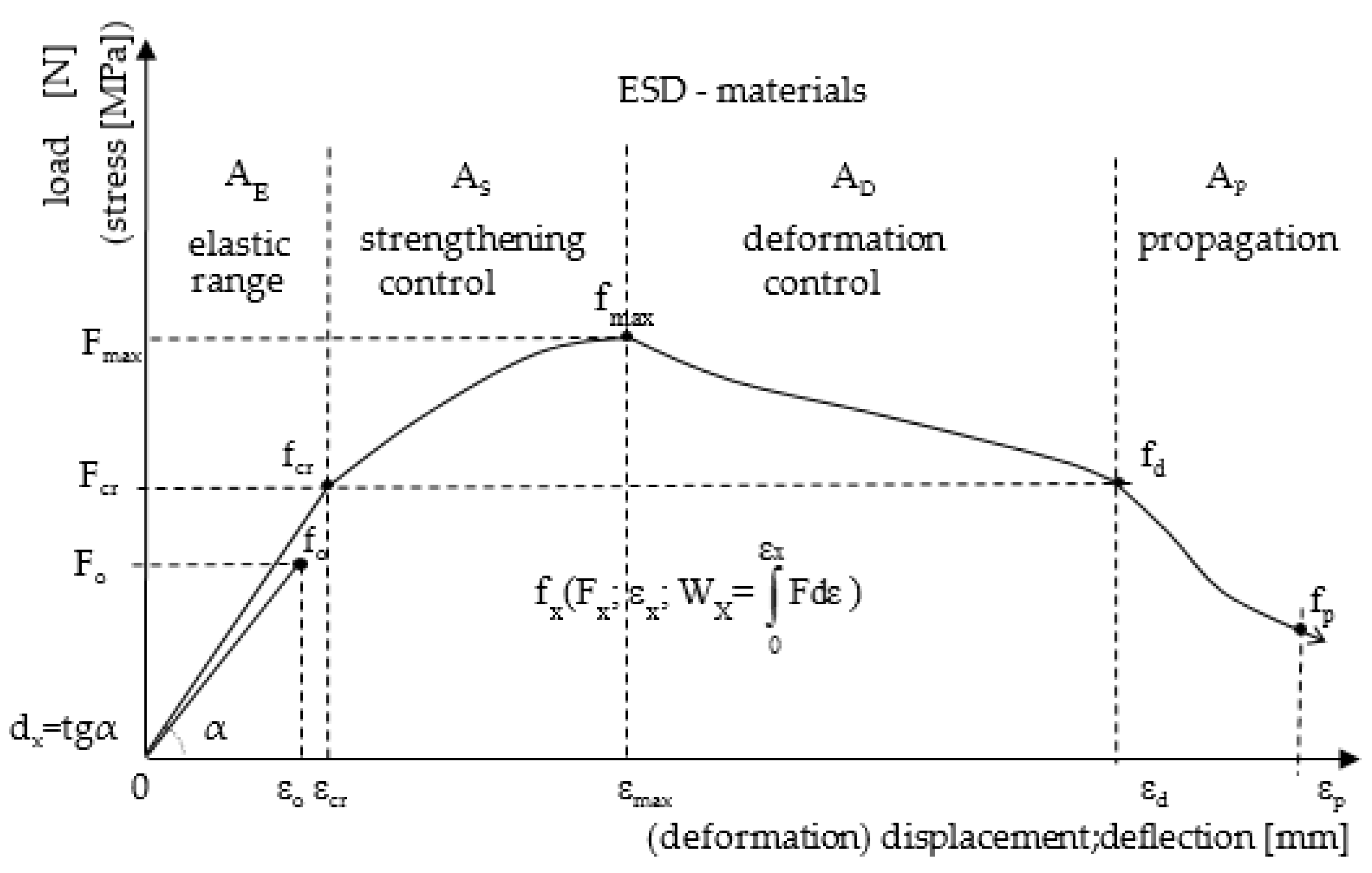
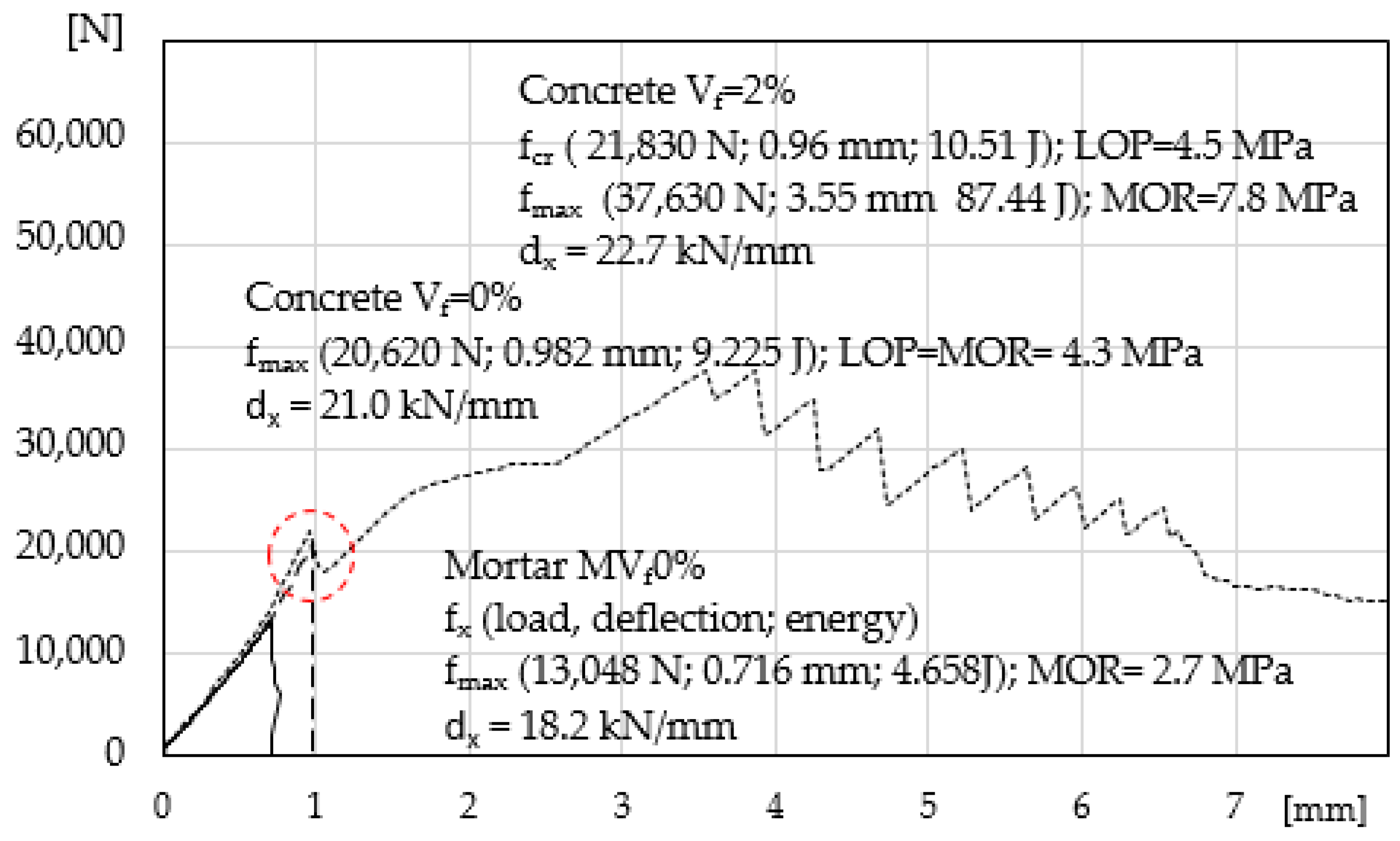

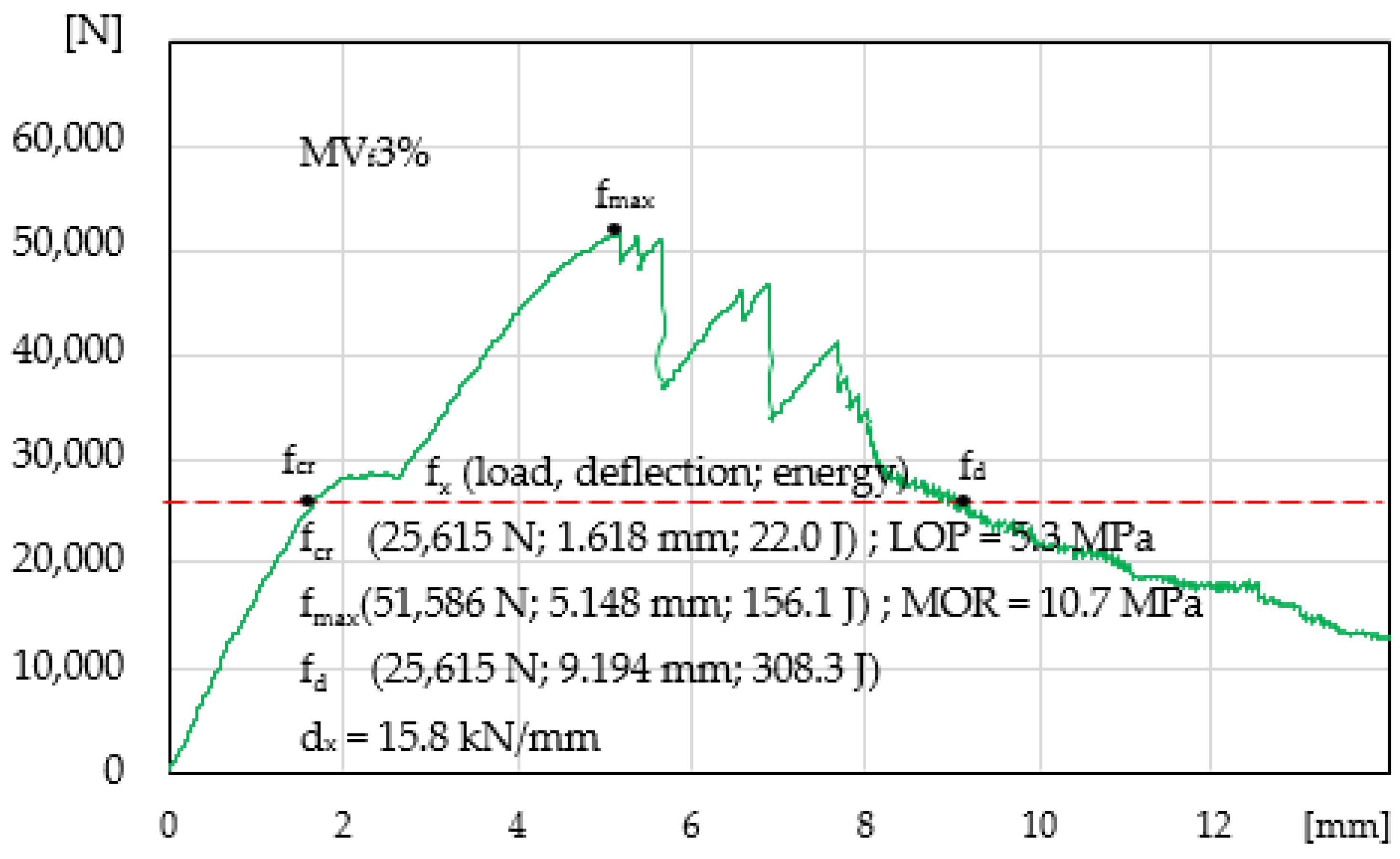
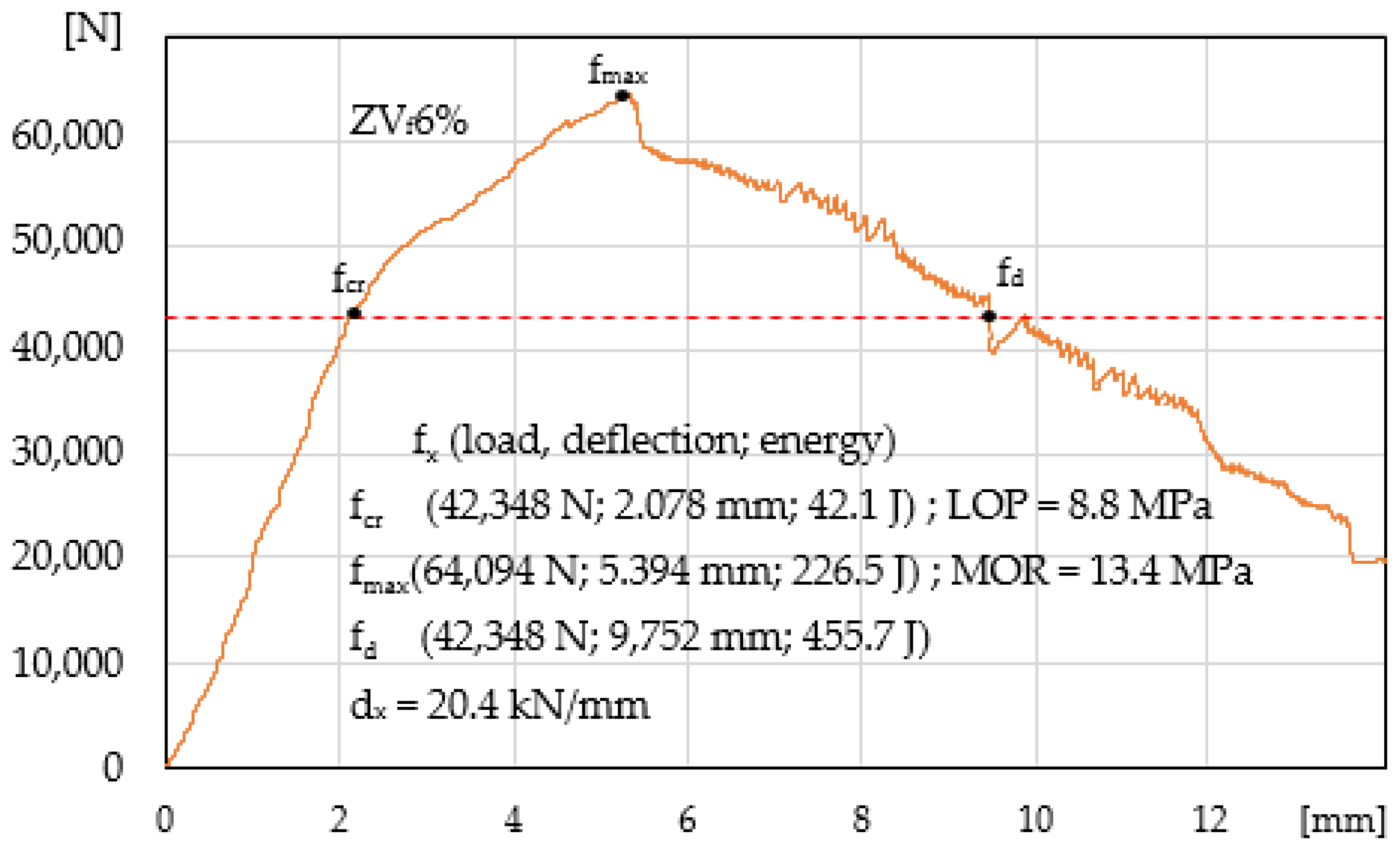


| Symbol | Specimen | Cement:Sand (Volume) | Vf [%] |
|---|---|---|---|
| MVf0% | mortar | 1:4.5 | 0 |
| MVf2% | mortar | 1:4.5 | 2 |
| MVf3% | mortar | 1:4.5 | 3 |
| ZVf6% | paste | - | 6 |
| Composite | Load | Deflection | Energy | LOP | MOR | dx |
|---|---|---|---|---|---|---|
| (N) | (mm) | (J) | (MPa) | (MPa) | (kN/mm) | |
| MVf0% | ||||||
| fcr = fmax | 13,048 | 0.716 | 4.7 | 2.7 | 2.7 | 18.2 |
| MVf2% | ||||||
| fcr | 16,730 | 0.887 | 6.8 | 3.5 | 18.7 | |
| fmax | 28,908 | 3.451 | 59.7 | 6.0 | ||
| fd | 16,730 | 7.228 | 142.8 | |||
| MVf3% | ||||||
| fcr | 25,615 | 1.618 | 22.0 | 5.3 | 15.8 | |
| fmax | 51,586 | 5.148 | 156.1 | 10.7 | ||
| fd | 25,615 | 9.194 | 308.3 | |||
| ZVf6% | ||||||
| fcr | 42,348 | 2.078 | 42.1 | 8.8 | 20.4 | |
| fmax | 64,094 | 5.394 | 116.5 | 13.4 | ||
| fd | 42,348 | 9.752 | 455.7 |
| Composite | Load (N) | Deflection (mm) | Energy (J) | LOP (MPa) | MOR (MPa) | dx (kN/mm) |
|---|---|---|---|---|---|---|
| matrix MVf0% | ||||||
| f0 = fcr = fmax | 13,048 | 0.716 | 4.7 | 2.7 | 2.7 | 18.2 |
| MVf2%/MVf0% | ||||||
| fcr/0 | 1.28 | 1.24 | 1.45 | 1.30 | 1.03 | |
| fmax/0 | 2.22 | 4.82 | 12.70 | 2.22 | ||
| fd/0 | 1.28 | 10.09 | 30.38 | |||
| MVf3%/MVf0% | ||||||
| fcr/0 | 1.96 | 2.56 | 4.68 | 1.96 | 0.87 | |
| fmax/0 | 3.95 | 7.19 | 33.21 | 3.96 | ||
| fd/0 | 1.96 | 12.84 | 65.60 | |||
| ZVf6%/MVf0% | ||||||
| fcr/0 | 3.25 | 2.90 | 8.96 | 3.26 | 1.12 | |
| fmax/0 | 4.91 | 7.53 | 24.79 | 4.96 | ||
| fd/0 | 3.95 | 13.62 | 96.96 |
Publisher’s Note: MDPI stays neutral with regard to jurisdictional claims in published maps and institutional affiliations. |
© 2021 by the authors. Licensee MDPI, Basel, Switzerland. This article is an open access article distributed under the terms and conditions of the Creative Commons Attribution (CC BY) license (http://creativecommons.org/licenses/by/4.0/).
Share and Cite
Logoń, D.; Schabowicz, K.; Roskosz, M.; Fryczowski, K. The Increase in the Elastic Range and Strengthening Control of Quasi Brittle Cement Composites by Low-Module Dispersed Reinforcement: An Assessment of Reinforcement Effects. Materials 2021, 14, 341. https://doi.org/10.3390/ma14020341
Logoń D, Schabowicz K, Roskosz M, Fryczowski K. The Increase in the Elastic Range and Strengthening Control of Quasi Brittle Cement Composites by Low-Module Dispersed Reinforcement: An Assessment of Reinforcement Effects. Materials. 2021; 14(2):341. https://doi.org/10.3390/ma14020341
Chicago/Turabian StyleLogoń, Dominik, Krzysztof Schabowicz, Maciej Roskosz, and Krzysztof Fryczowski. 2021. "The Increase in the Elastic Range and Strengthening Control of Quasi Brittle Cement Composites by Low-Module Dispersed Reinforcement: An Assessment of Reinforcement Effects" Materials 14, no. 2: 341. https://doi.org/10.3390/ma14020341
APA StyleLogoń, D., Schabowicz, K., Roskosz, M., & Fryczowski, K. (2021). The Increase in the Elastic Range and Strengthening Control of Quasi Brittle Cement Composites by Low-Module Dispersed Reinforcement: An Assessment of Reinforcement Effects. Materials, 14(2), 341. https://doi.org/10.3390/ma14020341







